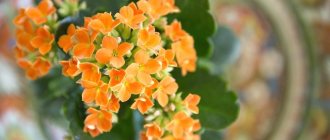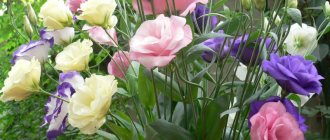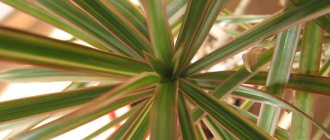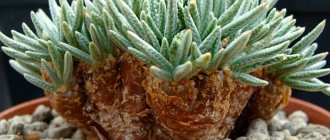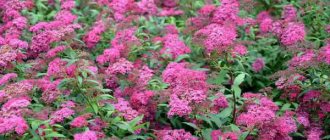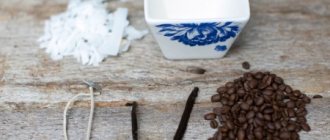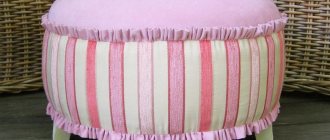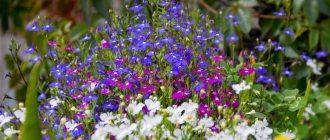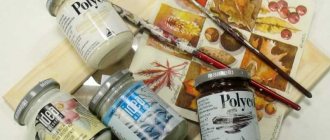- August 21, 2018
- Houseplants
- Ksenia Stepanishcheva
Almost everyone knows the fat woman. As you can see from the photo and name, the money flower is special. For some time it was customary to keep it at home for welfare. Another plant is called Crassula. The plant has special care features. The flowering of the money tree at home is original. You just need to create the right conditions for it.
Description
A photo of a money tree and a description of a houseplant allow you to find out its features. The Crassula genus includes 300-500 species of flowers. These include dwarfs, whose height is no more than a few cm, as well as tall trees growing up to 3-4 meters. Many species are perennials, but there are also annual species that die immediately after flowering.
What does a money tree look like? Most stems are erect or creeping herbaceous. There are shrubs with succulent fleshy or woody trunks, tall tree-like ones. The leaves of the plants are juicy and fleshy, covered with a waxy coating. They have a yellowish, greenish or blue tint, but in the sun they can take on a red or cherry tone. The money tree is an indoor plant that is known for its unpretentiousness and easy care.
Species found
- Crassula tree - this species is called the money tree
- Silver Crassula
- Crassula oval - also called money tree
The leaves are green or have a slightly silvery tint. The leaves may be edged with red or have red spots on the lower surface.
Benefit
The flower is believed to bring financial success. That's why it is called the money tree. It is also called the tree of luck, the monkey tree. Many people know that the fat woman has positive energy. But not everyone knows that it has healing properties; it is a filter plant. The phytoncides it produces have a pronounced antiviral, antibacterial, and antifungal effect; the flower disinfects the air.
Crassula juice treats:
- herpes, insect bites, cuts, abscesses, bruises;
- sore throat, gum inflammation;
- arthritis, other joint diseases.
The plant should not be taken orally as a medicine - it contains a lot of arsenic. The flowering of the money tree looks beautiful. At home, caring for the plant is simple and ensures normal growth and development of the flower.
How to care for a fat woman correctly
Money tree - home care and flowering
If you look at it in more detail, caring for a fat woman is quite simple. The entire range of activities can be completed quickly without wasting extra time. The main thing is to do everything strictly according to the rules of agricultural technology, keeping in mind the preferences of the plant itself.
For the fat woman, it is important that the room has good lighting. Therefore, it is recommended to place containers with plants on the southern or southeastern sides of the house. But during periods of high solar activity they will have to be shaded. When there is not enough sun, artificial lighting is added using ordinary lamps.
Sunburn of a flower
But it is better to purchase phytolamps, which are sold in special stores. They provide light similar to natural sunlight. The average indoor air temperature during the period of active growth should be between +21-26 degrees, and in winter – +11-16 degrees.
Crassula is a moisture-loving plant and it gets sick from a lack of moisture, as well as from its excess. To avoid the appearance of fungal spores and mold, the soil must be loosened after watering. It is also important what kind of water the flowers are watered with. If it is taken from the tap, then impurities of chlorine and other chemicals can cause intoxication. You should not water with hot water, as it can burn the roots and root zone. For proper watering, take water at room temperature after a certain period of settling. During the dry period, the crown is sprayed to maintain leaf density.
A money tree can bloom in a timely manner only with proper feeding. This is done once a month. It is better to use complex fertilizers. Feeding the plant begins with replanting, which also includes propagation of the bush. It is best to mix fertilizer with soil. To make the soil lighter, river sand should be added to it. If desired, you can purchase ready-made substrates.
Bush propagation
Important! You should not overfeed the bush. When applying fertilizer, the dosage of the drug is taken in accordance with the instructions on the package.
Kinds
What does a money tree look like? The photo shows that the flower has an incomparable appearance. The most common plants include the following:
- Crassula oval. This is a popular type of tree, which in nature can be 3 m high. And in an apartment the height is no more than 1.5 m. The plant is unpretentious in care and tolerates shade well.
- Crassula arborescens. The tree has bare branches and a trunk, fleshy, flat, ovoid leaves. It has white or pinkish flowers, collected in panicle inflorescences. But the money tree rarely blooms at home. Caring for it is the same as for the others, but the tree cannot tolerate shade.
- Crassula silvery. Compared to the previous 2 types, the money tree of this type is smaller. In other respects, the plant is similar to the oval and tree-like Crassula.
Of the creeping plants, the most popular are the following types of Crassula:
- lycophytes;
- pseudolycophytes;
- milky;
- point;
- tetrahedral;
- Cooper.
The genus Crassula has many species. Some of them are designed for an aquarium. But the most common species is the tree crassula.
In order for the money tree to bloom at home, care must be of high quality. It consists of moderate watering, periodic feeding, removing dust from the leaves, pruning and shaping the crown. Each of these procedures has its own characteristics.
Popular domestic species
Since childhood, a familiar flower has been decorating apartment windowsills for many decades. But not every amateur gardener knows that Crassula can have a very unusual appearance. It would seem that the simplest plant, Crassula, can surprise even experienced gardeners. These can be either ordinary trees or hanging species or plants that resemble moss.
Crassula leaves are smooth or covered with fine fluff, color from light green to dark green, red or orange. Some species have variegated coloring and edging. Sometimes plant leaves are covered with dotted spots or stripes.
Crassula Atropurpurea (C. Atropurpurea)
C. Atropurpurea var.
watermeyeri The leaves are back teardrop-shaped, the width of the plate is about 3 cm, the length is 5 cm. The surface of the leaf is rough. In winter and in the shade, the leaf color is green; with constant exposure to ultraviolet light, the color can change from pink to yellow-orange. It usually blooms in winter. The plant produces an erect peduncle on which small white inflorescences are formed.
Crassula Arborescens tree (C. Arborescens)
Crassula arborescens subsp.
arborescens This tall growing species can reach 1.5-3 meters in height. The crown is branched, the trunk is brown-green, dense, up to 20 cm in diameter. The leaves are fleshy, smooth with a waxy coating, and colored light gray. The surface of the leaf is strewn with small red dots, the edge is burgundy-red. Size from 2 to 5 cm in length, round shape, short petioles.
Brown's Crassula (C. browniana)
C. Browniana © Apostolou Stavros
A small tree with a dense stem. It grows quickly, the height of an adult plant is 20–30 cm. The leaves are about 0.5 cm in length. Branches, leaves and trunk are pubescent. Blooms throughout the summer.
Also read: Sedum - a beautiful close relative of the money tree
Crassula Ben (C. Capitella Ben)
C. Capitella Ben © Green Page
Beautiful decorative succulent, height up to 30 cm. Stems are erect, propeller-like leaves are wide, pointed. Aerial roots form in the internodes of each stem. If the stem is tilted towards the ground, it quickly takes root.
The sheet plates are stacked opposite each other. The leaf color is bright green with a red edge. The closer to the top, the smaller the size of the leaves. At the very top of the head, the leaves transform into bracts. The inflorescences are pointed, the flowers are star-shaped.
Crassula Brevifolia (C. Brevifolia)
C. Brevifolia © Wayne Fagerlund
An upright species of Crassula, the height of an adult plant is from 30 to 50 cm. The stems are strong, tree-like, brown. The leaves are spherical, fleshy, juicy, about 1 cm long, 0.5 cm in diameter, and grow in pairs. The leaf color is green with a reddish edge. With age, the color changes to yellow-red or purple. Flowering period is winter. The inflorescences are small and white.
Crassula Temple of Buddha (Buddha) (C. Buddha's Temple)
C. Buddha's Temple
An exotic slow-growing species with an annual growth of 5 cm. When the plant reaches 15–20 cm, it lies on the ground under its own weight and grows horizontally. The leaves are shiny and bright green in color. The root system is superficial. The flowers are pale red or pink.
Crassula Barklyi (C. Barklyi)
Crassula Barklyi
The popular name "bandaged finger" accurately describes the appearance of the plant. A miniature columnar species, only 5–10 cm high. The leaf blades fit tightly to the stem and overlap each other as they grow. The leaves are densely dotted with cilia, which absorb moisture and nourish the plant. Flowers are formed at the top, white in color, small in size. The inflorescences have a bright aroma. After the flowering period, the plant does not die.
Crassula Garnet Lotus (C. Garnet Lotus)
C. Garnet Lotus © Giromagi
The leaves are thick, fleshy, covered with a waxy coating that resembles frost. The foliage color is garnet-purple. The leaf blades form an erect rosette up to 15 cm in height and 15–20 cm in width. The leaves are wide, gradually narrowing towards the growing point. The flowering is bright and rich. The flowers are bright red and grow in clusters.
Crassula Gollum (C. Ovate Gollum)
C. Ovate Gollum © Apostolou Stavros
Slow-growing exotic succulent, popularly called “Shrek ears”. The leaf shape resembles a small funnel, which has a cup-shaped extension at the top. The crown is formed randomly, which is why adult plants have a different appearance. Height up to 0.5 meters.
Crassula Curly (C. Arborescens Curviflora)
Crassula arborescens curviflora
This species has distinctive wavy leaves. It is thanks to their shape that the plant got its name. This is a powerful, large plant with a voluminous crown. The leaves are silvery on top and the inside is reddish. There are dark dots on the outside of the leaf blade. The shape is a wide oval, length 5–7 cm, width 4–5 cm. There are two varieties that differ in the shape of the leaf plate and color.
Crassula Corymbulosa (capitella) (C. Capitella Corymbulosa)
Crassula Capitella Corymbulosa © CactusGarden
A plant with an erect crown, which grows over time and begins to spread along the surface of the soil. The stems, trunk and leaves are fleshy, strong, bright green in color. The inflorescences are small, the flowers are white.
Crassula Coral (C. Ovata Coral)
Crassula Ovata Coral © Little Prince Nursery
Common name for “skinny fingers”. The unusual leaves have an elongated shape that tapers towards the apex. It is noteworthy that one plant can have pointed leaves and leaves with a funnel-shaped expansion. Therefore, beginners often confuse Coral with Gollum. The flower grows quickly, the crown is lush, but is formed heterogeneously.
Crassula Marnier (C. marnieriana)
C. x rupestris f.
marnieriana “Hottentot” © gardenersworld.com Decorative species with a height of only 15–20 cm. The leaves are round and growing. tightly adjacent to the stem, and to each other. The leaf blades are covered with a protective warbler, which protects the plant from excessive evaporation of moisture. In young flowers, the shoots are located vertically, and with age they descend to the ground and spread along the ground. The leaf color is green with coral edging. Blooms in spring and winter. The inflorescences are umbellate, the flowers are white or pinkish. The shape of the flowers is star-shaped.
Also read: Peperomia - species that accumulate moisture
Crassula Morgan Beauty (C. Morgan's Beauty)
Crassula Morgan's Beauty © la-kosta.ru
An interesting succulent with beautiful and lush flowering. In winter and spring, inflorescences appear on the plant in the form of clusters. The color is rich, dark pink. The trunk is dense and thick. The leaves are located tightly to each other, colored silver-green.
Crassula Minor (C. Ovate Minor)
C. Ovate Minor © Green Acres Nursery & Supply
Miniature decorative succulent great for creating arrangements. The leaves are very small, from 1 to 1.5 cm long and only 1 cm wide. The plate is painted green along the edge of the sheet with a red edging. The plant reacts to lighting and can change the color of its leaves. The young plant has a soft green stem. With age, the trunk becomes woody and bare.
Crassula Nealiana (C. Nealiana)
Crassula Nealiana © Succulent.Market
A beautiful plant with horizontal shoots. The length of the branches is up to 15–20 cm. The leaves are dense and silvery in color. The inflorescences are small, formed on the tips of the shoots. In the sun, the color of the foliage changes and takes on a red tint.
Crassula ovata (C. ovata)
Crassula Ovata, Jade Plant (Big Leaf) © nestreeo
The most common species that grows on many windowsills of amateur and professional gardeners. This is a fairly large plant that can reach 1–2 meters. The crown is wide and branched. The leaves are round or oval, fleshy, dark green. Blooms in spring and winter, the inflorescences are white or pale pink.
Crassula Perforate (C. perforate)
Crassula Perforate © gardenia.net
A distinctive feature of this plant is the triangular leaves, which seem to be strung on the stem. The second name of the flower is “perforated”. This is a very tall perennial; an adult succulent can reach 3–4 meters. The shoots die off after flowering and fruiting. Only the basal part remains, on which the regenerating buds are located.
The flowers are small, yellowish or white. Plants with blue and red inflorescences are rarely found.
Crassula Pyramidalis (C. Pyramidalis)
Crassula pyramidalis variegata
A rather unusual and rare species of Crassula. A small plant with erect shoots. The crown is branching and grows rather slowly. On the main stem, several shoots can develop simultaneously and grow unevenly. An adult plant resembles cartoon cacti. Shoots are from 5 to 10 cm in length, 1 to 1.5 cm thick. The leaves are green, triangular in shape, thin and tender. The internodes are short so the leaves fit tightly to the stem.
Crassula moss and false moss (C. Muscosa)
Crassula Muscosa Lycopodioides
Herbaceous succulent with a shallow root system. The height of an adult plant is up to 20 cm. The roots are thin and delicate and therefore cannot go deep. Sometimes aerial roots form on the lower branches. The plant does not have a trunk, but in the center there is a main shoot, on the sides of which young shoots are formed. It blooms in winter, the inflorescences are yellow and green. The flowers have a delicate pleasant aroma. Sometimes another name is found: “mossy crassula”.
False-moss is a separate subspecies of Crassula, which differs only in the density of the leaves on the branch and color. Foliage colors are green, silver and white. Some plants combine several shades at once. The shoots do not grow straight upward, but can grow to the sides.
Crassula Rupestris (rock) (C. Rupestris)
Crassula rupestris “Tom Thumb”
Young plants have herbaceous shoots that become woody as they grow. The branches spread along the ground strictly horizontally. Sometimes only the tips of the shoots point upward. The height of an adult flower is up to 50 cm. The leaf shape, depending on the variety, can be ovoid or triangular. The leaves grow in pairs and have pointed edges. There are no petioles, so it seems that the leaves are strung on a stem. The leaf blades are light green with a dotted red edge.
Also read: Crassula the Hobbit and Gollum an unusual type of money tree
Crassula Springtime (C. Springtime)
Crassula Springtime © Succulents Box
A small compact plant with bright green, dense leaves. Young shoots are fleshy, about 3–4 cm in diameter, directed upward. The branches of adult succulents sag and touch the ground. With prolonged contact with the ground, roots develop on the shoots and the branches take root. Flowering is abundant, the inflorescences are light lilac.
Crassula Sunset (C. Ovata Hummel's Sunset)
C. Ovata Hummel's Sunset © Joyce-Tex-Buckner
This species has a very interesting red and yellow leaf color. But this color only appears in bright sunlight. The first flowering occurs at the age of seven, sometimes later. Crassula blooms in late autumn. The inflorescences are a beautiful pale lilac color. The shape of the flowers is star-shaped.
Crassula Tricolor (C. Ovata Tricolor)
Crassula Ovata Tricolor
A distinctive feature of the plant is its green leaves with white or cream stripes, which turn bright pink in the sun. The leaves are fleshy, dense, velvety. The shape of the leaves resembles an elongated drop. Due to the arrangement of the leaves, small rosettes are formed. An unpretentious plant suitable even for beginners.
Crassula Undulatifolia (C. Undulatifolia)
Crassula Undulatifolia © Mountain Crest Gardens
This species is distinguished from other plants by its dense, narrow leaves. The shape of the leaves is concave and therefore slightly wavy. The color of the leaves is silver-blue. The tips of the leaf blade are red. Sometimes a rather rare variegated color is found. The trunk is round and dense. With age it thickens and becomes woody.
Crassula the Hobbit (C. Ovata Hobbit)
Crassula Ovata Hobbit © Ezy Care Succulents
The height of an adult plant is approximately 50–60 cm. The leaves of the plant grow together from the base to the middle. The tops of the leaflets are widely spaced and have the appearance of a so-called “pumpkin”. The leaves seem to be turned outward. When grown correctly, the crown is quite compact and dense.
The stem becomes woody with age, so the plant is often used to create bonsai. The growth rate is average. The crown does not require trimming and is formed in the most bizarre ways. The outer side of the leaves is green, and the inner side has a rich burgundy-red color.
The plant does not tolerate direct rays well, so shaded window sills in a western and northern direction are best suited.
Crassula tetrahedral (C. Tetragona)
Crassula Tetragona “Pine”
The leaves are oblong and pointed, arranged crosswise. The shape of the leaves resembles needles or thorns. The color of shoots and leaves ranges from light to dark green. The plant grows upright, the height of adult bushes is up to 1 meter. With age, the plant grows and becomes like a small tree. And the appearance of the plant makes it look like perennial conifers. The shoots and leaves are juicy, hard, and voluminous. Leaves are 2 to 3 cm long. It blooms in summer, the flowers are white and are located at the top of the shoots.
Crassula Estagnol (C. Estagnol)
Crassula Estagnol
An unusual type of Crassula with a twisting trunk. The foliage, trunk and shoots are bright green. The leaves grow on top of each other, forming a rosette. Oval shape with tapered edges. It does not tolerate lack of light well, so it is best to place the plant in sunny windows. With a lack of lighting, the leaves turn pale, and the shoots stretch and weaken.
It is often joked about Crassulas that they are created for lazy people. And it’s really difficult to find plants that are just as easy to care for and don’t require specific knowledge about growing and propagating. Bright and unusual plants can complement any interior and fill the house with beauty and comfort. Among other things, fatty mushrooms have bactericidal properties. There are also many beliefs and signs about wealth and prosperity associated with plants.
Lighting
The money tree is an indoor plant that should be placed in areas with sufficient lighting. It is best to choose the southeast side. This is a recommendation not only from flower growers, but also from Feng Shui specialists.
It is necessary to control that direct sunlight does not fall on the plant, as this causes the flower to turn red, wither, and the foliage to fall. In the summer, it is advisable to take the tree out onto the balcony, and in the cold, move it to windows facing south.
Temperature
In spring and summer, the suitable temperature is 20-25 degrees. It is better to place the flower on a balcony or street, as it is difficult for the tree if there is a lack of fresh air. In winter, the plant is comfortable at 15 degrees, but not less than 4.
At room temperature, the flower can overwinter, but its leaves begin to wither and fall off. It is advisable not to place wood near heating radiators.
Pest and disease control
The fat plant begins to get sick only when the owners do not follow the rules for caring for the capricious plant. The most common problem is leaf loss. The reasons can be any: too much or too little sun, intensive watering, lack of moisture, abuse of fertilizers, lack of quality drainage.
That is why the first step in the treatment of any disease is to stabilize the watering and fertilizing regime.
Transfer
Judging by the photo, the flowers of the money tree are very beautiful. In this case, the plant periodically requires replanting. It is performed every 2-3 years, and if necessary, for example, when there is a strong growth of the flower. The transplant should be done in the spring into a pot that is slightly larger than the old one. You can use regular purchased soil, which is used for planting cacti and succulents.
You can prepare this soil substrate yourself if you mix turf soil and sand, as well as leaf soil in a ratio of 1:1:3. If there is a handful of humus, clay, or ash in the ground, the nutritional properties of the soil will improve. In order for the tree to grow, do not forget about drainage - expanded clay or crushed shards are needed.
In a pot, which is filled with drainage material and ¼ of the earth, you need to place the roots of the tree with a lump of earth. Then the voids are filled with a new substrate. After transplanting, the flower must be watered well. The soil should be loosened periodically to improve oxygen supply to the roots, and if the soil sags, then the top layer should be added to the pot. When the root is very long, it is shortened.
Trimming
According to the photo, the money tree flower will fit perfectly into a cozy home atmosphere. Maintenance includes regular pruning, which creates an attractive decorative appearance. Crown formation is performed when the plant is young.
When reaching 15-20 cm, pinch off the top 2 leaves. There will be branching in this area and 2 leaves will appear. As it grows, the top leaves must be removed in areas where branching of shoots is observed. Is it possible to trim the stems and leaves of an adult tree? This is allowed, but then in the area of truncated shoots there will be stumps that spoil the appearance.
Creeping Crassula
The types of Crassula presented below with photos and names are rarely found among home gardeners, although they have excellent decorative properties. The stems of this variety spread along the surface, forming a beautiful cover. Let's look at some types of plants included in this group:
- Crassula moss. The second name is mossy. The height of the bush does not exceed a quarter of a meter, the leaves are fleshy with four edges. The shoots spread along the ground, the tops rise slightly. The plates are small, similar to scales, which when folded resemble a moss moss. The variety does not require care and can grow in moderate shade. If the lighting is bright, the scales become slightly reddish. Often found in residential areas, several varieties can be found with different bush and leaf shapes.
- Crassula pseudomosula. It has more curved shoots than the previous one. The leaves lag further behind the stem and are not spaced as often. You can find cultivators that will delight you with bright leaves, silver or yellow.
- Tetrahedral Crassula - similar to the previous Crassula variety. The leaf is highly elongated, has a fleshy structure, length is up to 4 cm, width does not exceed 0.4 cm.
- Pointed Crassula - has high decorative properties, the stems spread along the ground and are highly branched. The leaves are covered with red dots, both on the outside and on the inside. There are barely noticeable eyelashes along the perimeter.
- Cooper's Crassula - has similar characteristics to those described above. Differs in smaller size.
Planting
Growing a beautiful tree requires proper care, as well as competent planting. The pot needs to be small and shallow, but wide and heavy. It is important that the container is stable. In a deep container, the root of the plant will tend downward, and the Crassula will stretch upward, so the trunk will be thin and weak.
What kind of land is required? The soil should include equal parts of leaf soil, turf soil and sand. Suitable soil includes turf soil, humus, leaf soil, sand, brick chips or fine gravel. The first component is taken in the amount of 3 parts, and the rest one at a time. After planting, the fat plant requires a temperature of 16-18 degrees, and watering once a day.
Recommendations
When growing a money tree, you must follow the following rules:
- The flower likes constancy, so it is not advisable to move the pot.
- Lack of light causes the trunk to lengthen and leaves to fall off massively.
- The money tree is peaceful in winter. During this period, it is advisable to place the plant in a room where the temperature is about 5 degrees. Watering should be done no more than once every 20 days.
- If the flower is placed on the windowsill, the leaves should not touch the glass.
Blooming crassulas
Officially, this group is not distinguished, but it was created for the convenience of choosing a home plant that will delight the owner with lush flowering that occurs once a year. Most species of Crassula practically do not throw out flower stalks, and if this happens, it is only in adulthood and when the required conditions coincide.
Crassula crescent
Perhaps the most remarkable variety, delighting the owner with large inflorescences (up to 20 cm) in the shape of an umbrella. Flowering occurs at the top of the shoot, which grows up to 1 meter in height. The leaves of this variety are thick, sickle-shaped, and have blunt tips. The base of the plate fits tightly to the barrel.
The inflorescences open every year. Usually this period falls at the end of summer.
Difficulties of growing
The money tree, like other indoor plants, is attacked by parasites. Therefore, it is important to know how to get rid of them. The most common parasites include:
- Spider mite. In this case, a thin cobweb appears on the leaves and stems. You can cure a tree using a soap solution, Aktellika, Fitoverma, Fufanon.
- Shield. It can be recognized by yellow and brown spots on the leaves. The fight is the same as for spider mites.
- Mealybug. The pest can be eliminated with a solution of laundry soap and insecticides. When there are few insects, they are removed with a cotton swab soaked in alcohol.
In addition to pests, other difficulties arise when growing a tree:
- The roots and base of the trunk rot. This appears when there is a lot of moisture. Crassula should not be watered frequently.
- Leaves wither. The phenomenon occurs when there is a lack of moisture.
- The leaves are falling off. This is due to watering with cold water, drafts, and lack of fresh air.
Drafts are harmful to Crassula, which lead to drying and shedding of leaves. Suitable conditions ensure normal growth and development of the plant.
What to do if Crassula does not produce buds
Money tree care secrets
Money tree owners often wonder how to make it bloom. This can be done if you create conditions that influence the development of Crassula. Most often, the flowering of the Crassula is blocked due to mistakes made by the owner. This in turn triggers the development of diseases and the appearance of pests.
Note! To avoid problems when growing indoor plants, in particular the money tree, it is necessary to follow the rules of agricultural technology, replanting and caring for them.
The most common problems that arise as a result of improper care of the fat plant and causing its lack of flowering are:
- Root and trunk rotting in the lower part. This occurs due to increased soil moisture when watering is too frequent.
- This can also happen if the room temperature is too low. Foliage wilting occurs as a result of the opposite reason. The problem can be solved by increasing the number of waterings and humidifying the air in the room.
- Yellowing, falling of leaves and barely formed buds occurs after watering with unsettled cold water and frequent ventilation in winter.
- If you place the plant in direct sunlight, burns may appear on the leaves and buds in the form of unsightly brown spots of a specific structure.
An affected money tree will not bloom until the causes of the disease can be eliminated. This means that you need to constantly inspect the plant so that if a problem arises, you can find out what pest or disease caused it.
Mealybug infestation
The most common diseases that occur when growing Crassula are:
- The appearance of a silvery coating. It covers the entire surface of the leaf blades and gradually completely covers the entire bush.
- Fungus. Its spores infect the root part of the plant. At first, a darkish spot of soft texture appears, and if treatment is not started in a timely manner, it will gradually rise to the very top of the trunk and destroy it.
- Chlorosis. With this disease, the castings become covered with a whitish-yellow coating, blocking access to sunlight. This makes it impossible to produce chlorophyll and causes iron deficiency.
In addition to diseases, pests have a negative impact on the development of the money tree and its flowering. They, like diseases, lead to the destruction of color. The most important pests that affect the Crassula:
- Spider mite. It develops on the leaves of the plant, feeding on their juicy pulp. You can notice the problem by a specific web on the branches. The mite does not allow the tree to develop normally and, of course, blocks its flowering.
- Mealybug. The first symptom of the lesion is visible by the presence of a white powdery substance around the trunk.
Important! To destroy parasites, the bushes are treated with fungicides. If the problem is not too severe, you can get by by thoroughly washing with warm water and soap dissolved in it.
Bloom
How does the money tree bloom? The photo shows that it can have very beautiful flowers. But their appearance is difficult to achieve even for professionals who know all the intricacies of care.
Thanks to care, the money tree blooms beautifully at home (photo above). Typically, white flowers appear on the plant when the tree is actively growing. Delicate flowers release pollen, which is why some people develop allergies when they bloom.
Money tree blossom
The scientific name of the plant, commonly called “money tree,” sounds like Crassula. It is also called Crassula. This home flower rarely pleases its owners with its flowering. To achieve such a joyful event, it needs proper care. The flowers on the bushes have a delicate white color, but there are varieties whose petals have yellowish or lilac shades.
Blooming money tree
It should be remembered that only a completely healthy, well-treated plant can bloom. There should be no dry or rotten branches on it. Such a tree should have a straight trunk, slightly thickened towards the roots, and branches with elastic, succulent leaves. Their oval plates of a dark green hue have a glossy sheen and a dense structure.
As a rule, Crassula blooms in late autumn or even early winter. But a period of wakefulness begins for the plant, like most indoor plants. That is, in early spring. In order to recover in a short period of rest immediately after flowering ends, the fat plant needs to be provided with an appropriate one. After all, in two months the flower should gain strength and begin to grow again in March.
Interesting! In order for the ornamental bush to begin to rest, you need to reduce watering, slightly lower the temperature in the room and limit access to sunlight.
There are special signs associated with when the money tree blooms. Some are related to the medicinal properties of the plant. But the majority still talk about the opportunity to attract good luck and prosperity in the financial sector:
- The appearance of flowers predicts profit for its owner. Moreover, the more active the flowering, the greater the amount will be.
- If a person catches the moment of the very first buds blooming, then his innermost wish will come true. And this will happen very soon.
- The beneficial property of the fat plant to cleanse the energy of the home is noted by Feng Shui masters. For this to happen, in their opinion, you need to place a flower pot on the southern or eastern windows of an apartment or house.
- To enhance the effect of helping in business, the branches of the crassula are tied in several places with red threads, on which are strung a pair of special coins.
Crassula is unpretentious in care. But despite all its endurance, it is impossible to force this plant to bloom in inappropriate conditions. But when the money tree begins to bloom, it is impossible to take your eyes off it. It seems as if the crown is covered with a light haze or a weightless cloud.
Reproduction
There are 2 methods of propagation: cuttings and seeds. Each of them has its own subtleties. Cuttings are the most convenient propagation method. This is done with stem segments and leaves. A large leaf or shoot must be cut with a sharp knife. The cuttings should be placed in a container of water until roots appear. To quickly form the root system and protect the stem from rot in the water, charcoal is added.
Cuttings can be planted directly into the ground. But in order for the tree to grow well, it is advisable to germinate the cuttings. They are planted in a pot with a diameter of 5-7 cm. A soil substrate is required, which includes the same amount of turf and leaf soil, and sand.
The flower can be propagated by seeds. They need to be sown in wide containers containing leaf soil (2 parts) and sand (1 part), covered with glass. Every day the crops must be ventilated and condensation must be wiped off the glass. After 2 weeks, seed germination is required.
The seedlings must be planted in soil, which includes leaf soil (1 part), turf soil and sand (½ part each). The container with seedlings should be placed under bright, diffused lighting. Grown Crassulas should be transplanted into pots with a diameter of 5-7 cm in soil, which includes leaf and turf soil, sand (identical parts). While the sprouts are taking root, they must be kept at 16-18 degrees. Then the flower is moved to a permanent place.
How to replant correctly
The flower does not require frequent replanting. The plant is replanted if the pot has become small, and you also need to divide the bush into several small ones. This is usually done once every 2-3 years.
They are replanting in the spring. There must be drainage at the bottom of the pot. It will protect the plant from overwatering, which means it will help prevent mold and rotting of the flower. The soil should consist of sand, leaf and turf soil. You can add clay and ash.
Crassula has a rather weak root system and a massive stem with thick, heavy leaves. Due to this discrepancy, the roots cannot hold the flower.
In the photo of the money tree you can see that the pots are usually chosen to be massive and large, stable and strong. This just helps prevent the flower from falling and reduces the load on the root system.
Useful tips
- Once a month you need to wipe the leaves from dust. You can wash them gently under a warm shower. You just need to cover the soil with polyethylene or wrap it with cling film. Excess water damages the roots.
- To prevent the plant from tipping over due to its own crown, you need to choose a pot with a wide, stable bottom. Heavy stones or glass balls are placed on the soil, which should not touch the trunk.
- Before planting or replanting, the soil must be disinfected. Even if it's store-bought. And freezing in the freezer or calcining in the oven eliminates many future problems. Additionally, the ground is watered with a hot solution of potassium permanganate. But after this, the plant can be planted no earlier than after 3 days, otherwise there is a risk of burning the roots.
These tips will allow you to grow a beautiful and well-groomed plant. Such a flower will not only be a symbol of wealth, but also a wonderful decoration for your home environment.
Useful properties of the flower
According to Feng Shui, a tree can bring money. The flower got its name precisely because of this belief and because its leaves resemble the shape of a coin. It is believed that the larger and fleshier the leaves, the greater the financial wealth in the house where it grows.
There is also a belief that the tree is able to take away negativity and everything bad, leaving only positive emotions.
If we talk about benefits from a scientific point of view, then the plant, like all others, purifies the air well. In folk recipes, Crassula leaves are often used to treat cuts and scrapes, coughs, and even eliminate hemorrhoids. All this is possible due to the fact that the leaves contain substances that promote regeneration and have an astringent and enveloping effect.
However, it is worth remembering that the plant is contraindicated for allergy sufferers, as it can cause an allergic reaction. Products based on it should not be used by children. The dosage should be carefully observed and not exceed the permissible concentration in home-made decoctions and ointments.
Where to buy?
You can buy a money tree in specialized flower shops, as well as in greenhouses and online stores. The price of a flower can vary, depending on its type, age and size. The average cost is:
- 600 rubles for Crassula Ovata (20 cm);
- 8500 – for a money tree (70 cm);
- 3700 – for Crassula Hobbit (50 cm).
This plant is unpretentious, usually care does not cause problems. In order for the plant to grow well and also attract financial success, you need to grow a tree yourself from a small shoot. Even novice gardeners can learn how to care for a flower.
